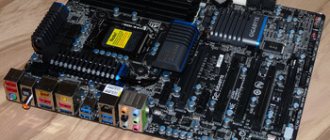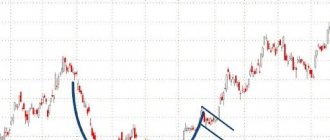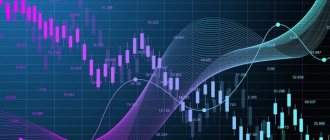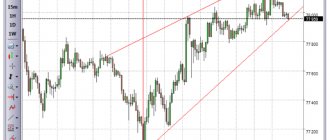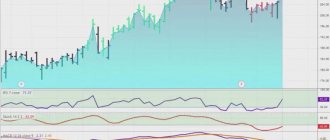We said earlier that traders have many trading styles. We can say that there are as many strategies as there are traders. After all, even the same tactics will look different in different hands, with their own nuances.
We have already discussed the general principles of trading using the scalping strategy. In this article we will talk about longer-term trading – intraday trading, which is called “intraday”.
Intraday trading or “intraday” is a very broad generalization, but there is a unifying rule: trades are not carried over to the next day.
What is intraday?
The “intraday” style is conventionally divided into “active” and “positional”. Active intraday aims to capture movements within one trading session and can involve both movement with and against price impulse. A positional approach may involve opening a position before the European (or even Asian) trading session and holding the position until the markets close (up to 3-4 hours of the American session).
The intraday style trader does not need to react instantly to microscopic imbalances between supply and demand (as is the case with scalping), so he can use a traditional candlestick chart with or without volume. Therefore, almost all markets are suitable for intraday trading, with some reservations.
Configuration
On the indicator settings screen, you need to configure some parameters. For an hourly time interval, the optimal combination is 13-5-3. We leave the limits for the excess of sales and purchases unchanged; by default they are equal to 30 and 70 points, respectively. But with increased volatility, this ratio can be changed to 20 to 80, which will allow you to discard more invalid signals.
In addition, you should pay attention to divergences recorded by the Stochastic indicator. Divergence is the discrepancy between the minimum/maximum values on the instrument and on the value chart.
The best market for intraday strategy
The best markets to day trade are those that are capable of generating smooth and powerful trending days , at least occasionally. There must be sufficient liquidity in the market (for correct execution of transactions and keeping risk at the proper level) and volatility.
Volatility is the cornerstone for day trading success. There are traditionally more and less volatile markets, but volatility sometimes appears where it was not expected, for example, on the USDRUB currency pair in March 2022.
It also happens that markets that previously showed high volatility lose it over time, for example, Bitcoin; while others, on the contrary, are increasing, for example, oil in 2022. Therefore, intraday traders migrate from one market to another , choosing the one that currently has the greatest opportunities for making a profit.
For an intraday trader, it is important to keep abreast of market sentiment and know what ideas and tools are currently “in play”. This is not about technical analysis, but about understanding the so-called “stock sentiment”. What market is in the news right now? Which market reflects the growing uncertainty and fears of investors?
Trading Forex intraday - what to pay attention to
Forex day trading is the least popular among experienced traders and the most popular among beginners.
If you are a beginner, we have an important tip for you: avoid trading on lower time frames (below the four-hour). First, try to make consistent money in the market throughout the year using Forex daily chart strategies. The more experience you gain, the more you will be able to make profits with smaller and smaller time frames. If, after all, you want to try your hand at intraday, we have some tips that might be helpful.
1) Develop a detailed trading plan, then strictly follow its risk management principles. As mentioned earlier, intraday Forex trading is riskier than long-term trading, mainly due to the higher speed and frequency of trades. Day traders are under more pressure and must be able to make decisions quickly and take full responsibility for the outcome. A trading plan is a must for a day trader.
2) Don't average your losses. Averaging is simply increasing losses. To avoid this, cut your losses quickly according to your exit strategy. Remember that by averaging losses, you lose not only money, but also time.
What and when do intraday traders trade?
There are also traders who stick to one market. Their task is to change trading tactics in a timely manner and synchronize with changes in volatility (and other parameters) of their trading instrument.
- If we talk about statistics in general, intraday traders often trade oil futures (CL or Brent) . Oil often shows sharp directional movements that continue throughout the day.
- Futures for stock indexes are often traded actively within one session, less often - positionally.
- Gold is a more difficult market to trade intraday.
- The effectiveness of trading currencies ( Forex ) largely depends on the volatility of the instrument and the skills of the trader. In general, currencies are a fairly difficult market to work on intraday.
For an intraday trader, it is permissible to work in the first hour of the opening of the trading session and then hold the position throughout the day, adjusting protective stops. A profitable position, of course, requires attention and management. Traders often encounter situations where accumulated profits instantly disappear due to a sharp counter-movement.
Who is suitable for intraday trading?
The “sponsor” of intraday trading is volatility.
The more the price fluctuates, the higher the trader's potential profit. There are nuances. The higher the volatility, the less predictable the price movement becomes. Therefore, this style is not suitable for everyone. As in any business, success depends entirely on the qualities of the trader. Long timeframes (weekly, monthly) make trading more comfortable. The trader has time to draw price lines, discover patterns and think deeply about whether to open a trade or not.
Hurry up to take advantage of the doubling of the tax deduction until December 31, 2022.
Day trading is the exact opposite of this. Everything happens very dynamically, an instant reaction is needed. When planning to master this area, improve skills such as composure, concentration, resistance to stress, and the ability to work quite quickly.
Unlike other strategies, intraday trading does not require patience; for many traders who do not want to wait long for the results of their work, this becomes a very tangible advantage.
Features of intraday work
If the scalper is trying to achieve a smooth growth of the balance curve, then the intraday trader builds the profitability of the entire month on several large days (often, no more than 3-5), while the rest of the time manages risks and keeps the trading account afloat.
Sometimes this can lead to emotional burnout: intraday traders quite often violate trading discipline and end up on tilt. Errors in trading are sometimes perceived painfully, the price captures a short stop and then moves towards their original forecast.
Think and evaluate realistically whether you can trade intraday and whether you have the required level of psychological stability. Fortunately, this is quite easy to evaluate: this style of trading does not require a high entry threshold and you can start with a small amount.
Let us remind you that we previously talked about the principles of operation of the scalping strategy. In the following articles we will talk about position trading and swing trading.
Read about trading and financial markets in our Telegram channel!
How to avoid unjustified risks
You can find a lot of material devoted to the mysteries of trading risk management.
For me, the following tips are most helpful:
- Always follow the one percent rule. The shorter the timeframe, the less predictable the price becomes and the higher the risks. Therefore, we will use the one percent rule and will not invest more than 1% of our budget in one transaction. This way we won’t lose our entire deposit in the first session.
- Set stop loss and take profit. On long timeframes there is time to assess the situation. In short periods everything is decided by seconds. Yes, there is a risk of not receiving enough money, but when trading with leverage, it is very easy to lose everything at once. Therefore, it is better to limit the potential loss.
- Do not open several transactions at the same time. In “sniper trading” systems on long time frames, this works. When trading intraday, it only increases the risks. We simply may not physically have time to react to the price change and will suffer losses.
No time to think
Another disadvantage is the lack of time to think.
Again, this point can also be regarded as an advantage, since the trader does not need to analyze anything. However, lack of time to think leads to spur of the moment trading.
The trader sees that the dynamics are beginning to increase. He is afraid that quotes may run too high.
Sometimes it is at this moment that missed opportunity syndrome (LOS) manifests itself.
Under the influence of this syndrome, traders begin to actively buy. As a rule, they make purchases when the price is at its maximum.
In short, the lack of time to think can be both an advantage and a disadvantage, since it leads to trading on the spur of the moment. In my case, as a rule, such trading never brought successful results.
Time
You have to wait longer to enter and complete a transaction. And the ratio of the profit (or loss) received to the time spent will not be high. Let me give you a visual example:
5 minute sideways
Day channel
Scalper tools
Almost all existing tools for analyzing and conducting transactions are suitable for intraday trading. Traders independently adjust their work, adjusting it to the specifics of short-term work. There are tools created specifically for scalpers. They are usually used by beginners, since they have not had time to form their own trading strategy, so they are forced to use other people’s developments.
Most scalping tools work on breakouts. That is, using an indicator or a system of various tools, the user determines the levels, overcoming which the movement will continue in the chosen direction. He places orders and monitors market behavior. As quotes move, it adjusts the levels of placement of trading positions.
Read also: How to remove biogel from nails?
The end of the Asian and the beginning of the European sessions is a good time for reversal setups
We all know that every daily candle has a body, an upper shadow and a lower shadow. Ideally, our task is to catch most of the body of the candle, i.e. catch the trend of the current day. But before the price moves towards the body, a shadow will form at the candle. And it is after the end of the formation of the shadow that we get a good moment to enter the market.
And the formation of a shadow very often ends at the end of the Asian / beginning of the European trading sessions. Accordingly, reversal setups that appear at this time have a high profit potential.
This advice is explained more clearly in the video tutorial at the beginning of the post.
Using Fibonacci Levels
Corrective Fibonacci leveling makes it possible to quite accurately predict the end of corrective movements, based on the well-known Fibonacci series. Thanks to the use of this technology, there is a considerable chance of entering the market in accordance with the current trend as soon as the pullback is over.
First, we need to detect a significant price fluctuation by placing the above levels on top of it in the direction from left to right. First of all, we are interested in levels with values of 38.2; 61.8; 50.0 percent.
Of particular importance in trading are pockets of concentration of Fibo levels, which can be formed by extending them over several successive trend movements. As tests show, such areas are difficult to overcome the cost schedule, which guarantees that the price “freezes” in this area.
Indicators for day trading
For successful day trading, it is important to use technical indicators, with the help of which traders make forecasts of future price changes. Since the most important thing in TA is price, all indicators that exist in technical analysis are based on the price of the asset. They compare the current price strength and direction of movement with a certain period in the past. As a result of the analysis, the trader receives certain conclusions, on the basis of which he makes trading decisions. ✅
indicators are used in day trading :
- Relative Strength Index (RSI);
- MACD indicator;
- Parabolic SAR indicator;
- Moving averages.
This is not the entire list. Read more about technical indicators

